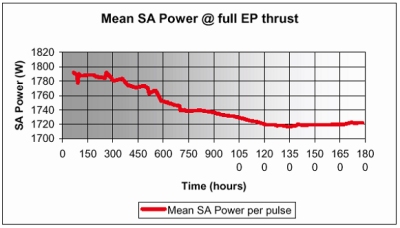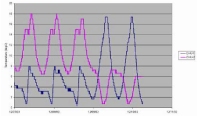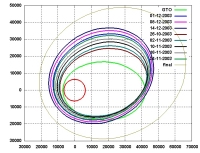No. 11 - Ion drive smashes 1000 hours milestone!
The procedure to automatically re-start the engine after a flame-out has been uploaded to the on-board software during the last week. The spacecraft can now be continuously operated in electric propulsion mode even at orbital altitudes belowe 10 000 km. Of course, according to the reciprocal of Murphy's Law, since we have uploaded this capability no flame-out events have occurred!
The total cumulated thrust so far of more than 1050 hours, consuming 16.7 kg of Xenon, has provided a velocity increment of about 740 ms-1 (equivalent to about 2660 km per hour). The electric propulsion engine's performance, periodically monitored by means of the telemetry data transmitted by the spacecraft and by radio-tracking by the ground stations, continues to show a small over performance in thrust, varying from 1.0% to 1.2% over the last week.
The degradation of the electrical power produced by the solar arrays has now virtually stopped. As a matter of fact the power available has remained virtually constant in the last 22 days and unusually a slight increase of 3 Watts has been noticed in the last week. This means that the degradation by radiation has matched the increase of solar irradiance due to the nearing of the Earth's perihelion (to be reached on January 3rd). Furthermore no direct proton radiation by solar activity was experienced by the spacecraft which now stays outside of the radiation belts for a considerable part of its orbit.
 |
|
This graph shows the measured power produced by the solar arrays when the EP is operating at full power. The time displayed is from the beginning of the mission up to mid December 2003. |
The communication, data handling and on-board software subsystems have been performing well in this period, despite an occasional loss of on-board time synchronisation between the main computer and the star tracker. This anomaly is currently being investigated.
The thermal subsystem continues also to perform well and all the temperatures are as expected. This week we made an orbital experiment to further investigate the issue with the temperature of the optical heads on the star trackers.
The current attitude profile has to maintain the correct thrust pointing and has to keep the solar array perpendicular to the Sun's direction. This provides the possibility to rotate the spacecraft by 180° around the Z-axis (thrust direction). We have exposed the -X face to the Sun instead of the usual +X face to see the effect this has on the optical heads' temperatures. The results are plotted in the graph below.
 |
|
Temperature of the two optical heads over time |
Orbital/Trajectory information
As anticipated some weeks ago, a series of long eclipses will be encountered in the period 3-24 March 2004 when the SMART-1 orbit's line of apses will be aligned with the Sun in the ecliptic plane and the apogee will cross the Earth's shadow. In order to limit the maximum eclipse duration to 2 hours and 15 minutes (total duration umbra and penumbra), a suitable thrust strategy has been devised. As a consequence, the electric propulsion system shall keep providing thrust until the end of January and then stop for about three weeks in February. This period will be used for instrument commissioning activity.
The osculating orbital elements are periodically computed by the ESOC specialists. These elements define the so called "osculating orbit" which would be travelled by the spacecraft if at that instant all perturbations, including EP thrust, would cease. So it is an image of the situation at that epoch. In reality the path travelled by the spacecraft is a continuous spiral leading from one orbit to another. The most recent osculating elements are as follows:
|
EPOCH (UTC) 2003/12/14 20:51:33.3 Elements WRT Earth (J2000) |
|
| Pericentre Distance (km) |
14 475.732289 |
| Apocentre Distance (km) |
50 496.229624 |
| Semi Major Axis (km) |
32 485.980957 |
| Eccentricity |
0.554401 |
| Inclination (deg) |
6.839341 |
| Asc. Node (deg) |
152.542919 |
| Arg. of Pericentre (deg) |
208.233502 |
| True Anomaly (deg) |
180.360409 |
| Osc. Orbital Period (h) |
16.186482 |
 |
|
SMART-1 orbit up to 14-12-2003 |
In this diagram the GTO, the osculating orbits at launch and at different times are plotted. The large orbit, marked 'final', is the one we expect to achieve at the end of the radiation belt escape in about two weeks time.
From the start, the electric propulsion system has managed to increase the semi-major axis of the orbit by 7856 km, increasing the perigee altitude from the original 656 km to 8097 km and the orbital period by five and a half hours, from the initial 10 hours 41 minutes to the present 16 hours 11 minutes.
Contact Point
Giuseppe Racca
SMART-1 Project Manager
ESA/ESTEC - SCI-PD
Keplerlaan 1- 2200 AG Noordwijk, The Netherlands
E-mail: Giuseppe.Racca esa.int
esa.int

